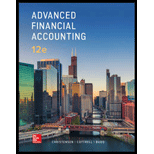
Advanced Financial Accounting
12th Edition
ISBN: 9781259916977
Author: Christensen, Theodore E., COTTRELL, David M., Budd, Cassy
Publisher: Mcgraw-hill Education,
expand_more
expand_more
format_list_bulleted
Question
Chapter 12, Problem 12.33P
(a)
To determine
Introduction: Translation is the method used to convert financial results of the business of subsidiary company into the functional currency of parent company.
A proof of the translation adjustment.
(b)
To determine
Introduction: Translation is the method used to convert financial results of the business of subsidiary company into the functional currency of parent company.
Whether U.S dollar strengthened or weakened against the local currency unit (MXP) during the year.
Expert Solution & Answer
Want to see the full answer?
Check out a sample textbook solution
Students have asked these similar questions
Solve this MCQ
What is the ending total assets balance ?
calculate the total capitalized cost of the production equipment
Chapter 12 Solutions
Advanced Financial Accounting
Ch. 12 - Prob. 12.1QCh. 12 - Prob. 12.2QCh. 12 - Prob. 12.3QCh. 12 - How widely used are IFRS? Can IFRS be used for...Ch. 12 - Prob. 12.5QCh. 12 - Prob. 12.6QCh. 12 - Prob. 12.7QCh. 12 - Prob. 12.8QCh. 12 - Prob. 12.9QCh. 12 - Prob. 12.10Q
Ch. 12 - Prob. 12.11QCh. 12 - Prob. 12.12QCh. 12 - Prob. 12.13QCh. 12 - Prob. 12.14QCh. 12 - Prob. 12.15QCh. 12 - Prob. 12.16QCh. 12 - Prob. 12.17QCh. 12 - Prob. 12.18QCh. 12 - Prob. 12.19QCh. 12 - Prob. 12.20QCh. 12 - Prob. 12.4CCh. 12 - Prob. 12.5CCh. 12 - Prob. 12.6CCh. 12 - Prob. 12.7CCh. 12 - Prob. 12.1.1ECh. 12 - Prob. 12.1.2ECh. 12 - Prob. 12.1.3ECh. 12 - Prob. 12.1.4ECh. 12 - Prob. 12.1.5ECh. 12 - Prob. 12.1.6ECh. 12 - Prob. 12.1.7ECh. 12 - Prob. 12.2.1ECh. 12 - Prob. 12.2.2ECh. 12 - Prob. 12.2.3ECh. 12 - Prob. 12.2.4ECh. 12 - Prob. 12.2.5ECh. 12 - Prob. 12.2.6ECh. 12 - Prob. 12.3ECh. 12 - Prob. 12.4.1ECh. 12 - Prob. 12.4.2ECh. 12 - Prob. 12.4.3ECh. 12 - Prob. 12.4.4ECh. 12 - Prob. 12.4.5ECh. 12 - Prob. 12.4.6ECh. 12 - Prob. 12.4.7ECh. 12 - Prob. 12.5ECh. 12 - Prob. 12.6ECh. 12 - Prob. 12.7ECh. 12 - Prob. 12.8ECh. 12 - Prob. 12.9ECh. 12 - Prob. 12.10ECh. 12 - Prob. 12.11ECh. 12 - Prob. 12.12ECh. 12 - Prob. 12.13ECh. 12 - Prob. 12.14ECh. 12 - Prob. 12.15ECh. 12 - Prob. 12.16PCh. 12 - Prob. 12.17PCh. 12 - Prob. 12.18PCh. 12 - Prob. 12.19PCh. 12 - Remeasurement Gain or Loss Refer to the...Ch. 12 - Prob. 12.21PCh. 12 - Remeasurement and Proof of Remeasurement Gain or...Ch. 12 - Translation Palermo Inc. purchased 80 percent of...Ch. 12 - Prob. 12.24PCh. 12 - Prob. 12.25PCh. 12 - Prob. 12.26PCh. 12 - Prob. 12.27PCh. 12 - Prob. 12.28PCh. 12 - Prob. 12.29PCh. 12 - Prob. 12.30PCh. 12 - Prob. 12.31PCh. 12 - Prob. 12.32PCh. 12 - Prob. 12.33P
Knowledge Booster
Similar questions
- Can you explain this financial accounting question using accurate calculation methods?arrow_forwardThe F Company sold the land for $86,000 in cash. The land was originally purchased for $56,000, and at the time of the sale, $17,000 was still owed to First National Bank on that purchase. After the sale, The F Company paid off the loan to First National Bank. What is the effect of the sale and the payoff of the loan on the accounting equation? 1. assets increase by $20,000; liabilities decrease by $15,000; owner's equity increases by $5,000. 2. assets increase by $60,000; liabilities decrease by $15,000; owner's equity increases by $20,000. 3. assets increase by $13,000; liabilities decrease by $17,000; owner's equity increases by $30,000. 4. assets increase by $20,000; liabilities decrease by $15,000; owner's equity increases by $35,000arrow_forwardAccounting answer with right solutionarrow_forward
arrow_back_ios
SEE MORE QUESTIONS
arrow_forward_ios
Recommended textbooks for you
